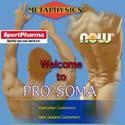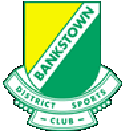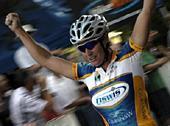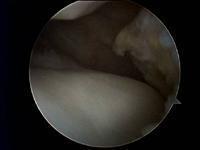
 |
 |
 |
 |
 |
 |
 |
 |
 |
 |
 |
 |
 |
 |
 |
 |
Speedy Gilmore: The Rochelle Gilmore Journal 2004
Rochelle Gilmore - super sprinter and scratch race silver medallist at the 2002 world track championships - is a woman full of ambition. After proving her prowess on the track, she's aiming to forge a successful career on the road, and in 2004, she'll riding for Denmark-based Team S.A.T.S. Follow Rochelle as she attempts to rise to the top of the tree in 2004.
July update: Part II
Operation Patella
|
|
|
|
I am really being tested!
Things were finally starting to look up during my training and preparation in Italy for the Giro. I was consistently feeling good on the bike and my health was great.
My final hard training session was last Wednesday, two days before the start of the 2004 Giro d'Italia. This is the day disaster struck for the sixth time in eight months - talk about a run of bad luck!
It all started when I was hit by a car last December, where I had stitches in two places on my face. The racing season then started off on a bad note when I pulled my foot twice during sprint finishes in the Geelong Tour, finished off with a puncture in the final 3km of the first World Cup of the season! My next hand-brake was an illness I struggled with for a month leading into the World Track Championships - fortunately I managed to get a grip on that just in time for a good performance at World's, but as you may know I crashed and broke my collarbone with two laps to go! A quick recovery from that operation (7cm pin inserted and bone graft) allowed me to start intense, structured training a few weeks out from the start of the Giro d'Italia.
Last Wednesday, I headed out with the AIS girls in Italy for a 3-4 hour ride with efforts, my first two efforts were 40 second power hill sprints... they went well. My final effort for the day was to sit behind the AIS girls doing a team time trial on their TT bikes with disc wheels (practicing for the crucial TTT in the middle of the Giro). We floated (well I floated while they swapped off at full speed) along a flat road for about 8km, as we turned right and hit a hill - I was to sprint past the girls for a final 200m to finish off my effort. The TTT girls continued up the hill for several more kilometres.
The sprint went fine but as I finished the sprint, I free-wheeled (only for 3-5 seconds) then the next pedal stroke killed! It was so painful that I had to turn and roll down the hill. Every pedal stroke hurt for the entire 40km ride home.
I rode straight to the farm house to be treated; Gabby did some deep-tissue massage on the quads, an ITB release and iced the knee. I also took some anti-inflammatories. The orders were then to rest up until the Giro, icing, treatment (massage) and stretching.
The next time I threw my leg over the bike was on Friday evening to warm up for the Giro d'Italia prologue. I was going for it on the ergo trying to block out the pain; it was pouring down rain, so I wanted to stay on the ergo under shelter until just before the start. The prologue was only 2.8km, and being wet and dangerous, I thought I could pull off a good ride.
Would you believe this: I rolled up to the start ramp to be told I had missed my start by three minutes! They said I better get going if I wanted to make the time cut! I finished with about seven and a half minutes on a course that was taking about four and a half mins to ride! Not a good start! So I went back to the hotel for my treatment and went to sleep with my fingers crossed for the next day!
From the first pedal stroke on day one of the Giro d'Italia I knew it was over for me. After 10km I went back to the convoy to ask the race doctor for an anti-inflammatory; he gave me one and said try to push through for half an hour. The stage was not particularly hilly, but my knee was hurting going downhill, it was that bad! I spoke to Natalie Bates (AIS rider/physiotherapist) and Margaret Hemsley (also a physiotherapist) during the race, and I was fighting the tears from the pain and disappointment. Nat and Margi were both being positive and encouraging me to try and get to the end of the stage, so I would have the option to continue the next day. It was not long before I had to take the pressure off the pedals, I could not even ride slowly to the finish, I had to get off the bike. Only I knew how bad it actually was.
I was devastated after the race and I was amazed at the support from the AIS girls in particular and also my team (SATS), who I have let down many times this year!
The only approach I could take was, 'Let's find the problem.' So my team flew me straight to Denmark to see the best knee specialist in the country. It was Wednesday at 1pm that I saw the specialist; after examining me, he was confident he knew exactly what the problem was (in simple terms, a fold under the patella being pinched when I bent the knee). He said I would need surgery which would require about six weeks of rehabilitation and treatment before commencing hard training or racing. I asked about 10 times, but what about, or what if, is there any other option, etc.
The doctor said there would be a 10 percent chance of it healing with complete rest BUT it would take more than six weeks. I asked if I could wait two weeks and see if it gets better. He said he was confident that I would not experience any improvement, and I would be back there deciding to have surgery - two weeks would be wasted.
I had no choice, although I was very dubious that he could know the exact problem without any scans or X-rays. I asked if we could put a camera in there and have a look before deciding on surgery; he said if he sees the problem, he would want to fix it right away while I'm there.
I was then faced with the option of having the surgery under local anaesthetic in two hours time OR wait until the surgeon returned from his holiday a couple of weeks later to go under a general anaesthetic.
If it was going to be done, it had to be now!
Wow, those local anaesthetics hurt - I had three! Then the procedure was pain-free.
Once the camera was inserted, the doctor said: 'Look at that, exactly what I expected - only a lot worse!' I was watching on the screen too and it looked like the knee was ripped to shreds! He then confirms that this injury would never have healed naturally, so the right decision had been made.
I lay there, watching him cut away at the tissue that was being pinched; the technical wording for the problem was, 'A large synovial plica was found medially trapped under the patello-femoral joint'... causing excruciating pain!
You can see the before and after photos of inside my knee. I have the entire procedure (inside knee) on DVD! It's amazing technology!
From looking at the pictures, you can see it looks like the problem has been solved. I will keep you updated with the progress. The doctor says after two weeks I can spin lightly on an indoor trainer and progress from there.
Cheers,
Rochelle
Photography
Images by Rochelle Gilmore & friends
- Before - at the top of the picture is the bottom of the knee cap (bone). Sitting under the knee cap is a large synovial plica which is not meant to be there. At the bottom is the little knife that cuts and sucks at the same time - the aim is to cut away enough tissue so that when the knee bends (top bone moves down towards the bone at the bottom of pic), it does not pinch anything!
- After - as you can see here, all the tissue between the two bones has successfully been removed. Nothing to be pinched - no more pain :-) Amazing, isn't it!

